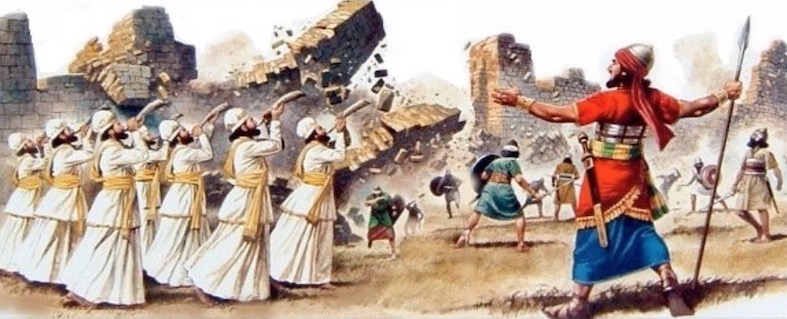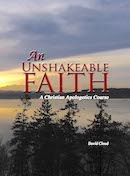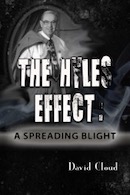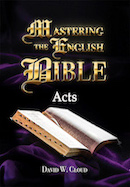866-295-4143, fbns@wayoflife.org

Moon-worshiping Jericho was the first idolatrous Canaanite city that was conquered when Israel crossed the Jordan River. (Illustration from "Bible Times and Ancient Kingdoms" PowerPoint set)
Of all of the biblical events associated with this place, perhaps the most fascinating is the account of the conquering of Jericho itself by Joshua and Israel. And the witness of this account lies at the feet of the modern visitor to the Jericho tel, right in the midst of the modern city.
In the early 20th century it was assumed that the Bible’s account of the conquest of Jericho in the 15th century BC had been confirmed by the excavations of British archaeologists John and J.B.E. Garstang (1930-36). Their report included photographs of the collapsed walls. They stated that “there is no difficulty now in understanding the note of confident faith which breathes in every line of the Bible narrative.”
In light of the skepticism that permeates the field of archaeology, we would be surprised if such a bold statement were left uncontested. Sure enough, the challenge came a couple of decades later from Kathleen Kenyon who excavated Jericho between 1952-58. She claimed that the city was abandoned at least 150 years before Israel came into the land. Her conclusion was as follows:
“It is a sad fact that of the town walls of the Late Bronze Age, within which period the attack by the Israelites must fall by any dating, not a trace remains … The excavation of Jericho, therefore, has thrown no light on the walls of Jericho of which the destruction is so vividly described in the Book of Joshua” (Kenyon, Digging Up Jericho, 1957, pp. 261-262).
Kenyon’s view prevails. Israel Finkelstein, director of Tel Aviv University’s Institute of Archaeology, is typical in saying that “it’s not a possibility” that Canaan was conquered by Israel as the Bible describes.
John Garstang answered Kenyon and other critics in 1948 in The Story of Jericho.
“In this revision he sought to deal with opinions that conflicted with his conclusion that Jericho fell in 1400 BC. Garstang observed that few of these opinions were based on first-hand knowledge of the results of his excavation at Jericho and that many were lacking in logical reasoning or were based on pre-conceptions concerning the date of the Exodus. ... He saw no need to discuss the date of the fall of Jericho ‘as though it were a matter of debate,’ and said that if there had not been a controversy concerning the date of the Exodus, there probably never would have been any question of the date of Jericho’s fall. He concluded that the date of 1400 BC was plainly indicated by the evidence, which the reader ‘may examine for himself’ (The Story of Jericho, p. xiv)” (Joseph Free, Archaeology and Bible History, p. 112).
Garstang held to the documentary theory of the Pentateuch, but his archaeological research convinced him that “the historical narrative contained in the Books of Joshua and Judges ... was founded upon fact” (The Story of Jericho, p. 341). He spoke of their “remarkable accuracy and fullness of topographical detail.”
Bryant Wood, who has a Ph.D. in Syro-Palestinian archaeology from the University of Toronto and is an expert in pottery dating, has also concluded that Kenyon was wrong. In an independent review of the evidence, he found the following: (1) Kenyon ignored evidence, such as certain types of pottery and amulets that would place the date of the destruction at the time of Israel’s entrance into the land. In an earlier excavation in the 1930s, John Garstang had found distinctive pottery decorated with red and black designs that was in use only in the latter part of the 15th century BC, the exact time of Israel’s conquest of the land. (2) She ignored the fact that the condition of the ruins perfectly match the Bible’s description of the city’s destruction. She found that the walls had collapsed outward and that the city had been burned. She even noted that the walls were collapsed before the city was burned (“Jericho: Does the Evidence Disprove or Prove the Bible?” Bible and Spade, Spring 2003).
Dr. Wood further examined the excavations of Jericho by an Italian-Palestinian team conducted in the 1990s (Lorenzo Nigro and Nicolo Marchetti under the auspices of the Palestinian Department of Archaeology) and had his picture taken by the retaining wall. The retaining wall held the high walls in place and when the main walls fell the bricks collapsed over the retaining wall to form a ramp for the Israelites to enter the city. The Italian-Palestinian team brashly stated that they saw no evidence for the biblical account, but men see what we want to see! God’s Word calls the skeptics “willingly ignorant” (2 Pe. 3:3-5). Their skepticism is not based on facts; it is based on the motive to “walk after their own lusts” and not to submit to the God of the Bible.
When the wrong dating is corrected, the evidence at the Jericho tell fits perfectly with the biblical record, as follows:
1. The city was strongly fortified at the time of Joshua. The Canaanite cities were described by Moses as “great and fenced up to heaven” (De. 9:1). In the case of Jericho, there was a double wall. The outer wall consisted of a retaining wall 12-15 feet high, on top of which was a mudbrick wall six feet thick and 20-26 feet high. Inside the outer wall was an embankment that sloped up to the city. On top of this embankment was the inner wall, which was about 12 feet thick and 20-26 feet high. Therefore the top of the inner wall was about five stories above the ground level on which Israel marched around the city.
2. The city walls collapsed and formed a ramp, allowing the Israelites to go straight ahead and enter the city. “So the people shouted when the priests blew with the trumpets: and it came to pass, when the people heard the sound of the trumpet, and the people shouted with a great shout, that the wall fell down flat, so that the people went up into the city, every man straight before him, and they took the city” (Jos. 6:20).
3. The city was burned. “And they burnt the city with fire, and all that was therein” (Jos. 6:24). “Once again, the discoveries of archaeology have verified the truth of this record. A portion of the city destroyed by the Israelites was excavated on the east side of the tell. Wherever the archaeologists reached this level they found a layer of burned ash and debris about one meter (three feet) thick. Kenyon (Excavations at Jericho) described the massive devastation as follows.’The destruction was complete. Walls and floors were blackened or reddened by fire, and every room was filled with fallen bricks, timbers, and household utensils; in most rooms the fallen debris was heavily burnt, but the collapse of the walls of the eastern rooms seems to have taken place before they were affected by the fire’” (Bryant Wood, “The Walls of Jericho,” Answers in Genesis, Mar. 1, 1999).
4. The walls fell before the city was burned. Kenyon found “a large deposit of red bricks outside the revetment wall, which formed a sloping incline from the top of this retaining structure to ground level. Both Kenyon and other archaeologists believe these bricks were the remains of the walls surrounding the city” (Garry Brantley, Digging for Answers, p. 62). These bricks were not burned, proving that they fell before the city was burned and not as a result of the burning of the city, just as the Bible says.
5. Part of the city wall with attached houses was left standing on the north side. This was probably where Rahab’s house was located. “Then she let them down by a cord through the window: for her house was upon the town wall, and she dwelt upon the wall” (Jos. 2:15).
6. Containers filled with grain was found in the excavations. The Bible says the city was taken at the time of harvest (Jos. 3:15). The fact that the grain was found in the ruins of the ancient city, in spite of its great value, fits the biblical account that Joshua forbad the people to take anything from the city for personal use (Jos. 6:17-19). “Both Garstang and Kenyon found many storage jars full of grain that had been caught in the fiery destruction. This is a unique find in the annals of archaeology. Grain was valuable, not only as a source of food, but also as a commodity which could be bartered. Under normal circumstances, valuables such as grain would have been plundered by the conquerors” (Wood).
The containers filled with grain also point to a short siege. In a long siege, the grain would have been consumed by the inhabitants, which doubtless included people from the surrounding towns and villages who were trying to find safety from Israel.
7. The city was not rebuilt. It was cursed by Joshua. “And the city shall be accursed, even it, and all that are therein, to the LORD” (Jos. 6:17). Like Chorazin, Bethsaida, and Capernaum (Mt. 11:20-24), the ruins of ancient Jericho stand today in silent witness to the truth of God’s Word and to the judgment of God on unrepentant sinners.
Dr. Wood concludes as follows: “Jericho was once thought to be a ‘Bible problem’ because of the seeming disagreement between archaeology and the Bible. When the archaeology is correctly interpreted, however, just the opposite is the case. The archaeological evidence supports the historical accuracy of the biblical account in every detail. Every aspect of the story that could possibly be verified by the findings of archaeology is, in fact, verified.”
Wikipedia’s article on Bryant Wood says, “He is known for his 1990 proposed redating of the destruction of Jericho to accord with the biblical chronology of c. 1400 B.C. The proposal was later (1995) contradicted by new radiocarbon evidence, and Kathleen Kenyon's dating of c. 1550 B.C. remains the date accepted in scholarly publications.”
(In my experience, Wikipedia should never be trusted when it deals with people and topics touching on the defense of the Bible.)
Actually, the radiocarbon evidence is inconclusive (which is typical) but it actually falls against Kenyon’s dating and gives support for Wood’s position! See http://creationwiki.org/Jericho_chronology_dispute
Further, Wood gives several important reasons why Kenyon’s analysis should be rejected, none of which are mentioned in the Wikipedia “hit piece.” Consider the following:
First, she only excavated one-third of the territory that her predecessor John Garstang had excavated in the 1930s.
Second, she claimed that Cypriot bichrome pottery was absent from the site and that this was evidence that Jericho had ceased to exist by 1400 B.C., but Garstang had published descriptions of a “considerable quantity of pottery decorated with red and black paint which appears to be imported Cypriot bichrome ware, the type of pottery Kenyon was looking for and did not find” (Wood, 1990, 16[2]:52).
Third, she ignored evidence that she herself had unearthed that points to a 1400 B.C. destruction of the city. This consisted of bowls, cooking pots, and small dipper juglets “all of which were characteristic of the Late Bronze Age (c. 1550-1400 B.C.)” (Garry Brantley, Digging for Answers, p. 61).
Fourth, she ignored the amazing archaeological facts that confirm the Bible’s account of the fall of Jericho, which we have examined in this report. She found the walls of the city and she found that they had fallen down in the manner described in the Bible. She found the massive burning. She found the grain.
- Receive these reports by email
- www.wayoflife.org
______________________
Sharing Policy: Much of our material is available for free, such as the hundreds of articles at the Way of Life web site. Other items we sell to help fund our expensive literature and foreign church planting ministries. Way of Life's content falls into two categories: sharable and non-sharable. Things that we encourage you to share include the audio sermons, O Timothy magazine, FBIS articles, and the free eVideos and free eBooks. You are welcome to make copies of these at your own expense and share them with friends and family. You may also post parts of reports and/or entire reports to websites, blogs, etc as long as you give proper credit (citation). A link to the original report is very much appreciated as the reports are frequently updated and/or expanded. Things we do not want copied and distributed are "Store" items like the Fundamental Baptist Digital Library, print editions of our books, electronic editions of the books that we sell, the videos that we sell, etc. The items have taken years to produce at enormous expense in time and money, and we use the income from sales to help fund the ministry. We trust that your Christian honesty will preserve the integrity of this policy. "For the scripture saith, Thou shalt not muzzle the ox that treadeth out the corn. And, The labourer is worthy of his reward" (1 Timothy 5:18). Questions? support@wayoflife.org
Goal:Distributed by Way of Life Literature Inc., the Fundamental Baptist Information Service is an e-mail posting for Bible-believing Christians. Established in 1974, Way of Life Literature is a fundamental Baptist preaching and publishing ministry based in Bethel Baptist Church, London, Ontario, of which Wilbert Unger is the founding Pastor. Brother Cloud lives in South Asia where he has been a church planting missionary since 1979. Our primary goal with the FBIS is to provide material to assist preachers in the edification and protection of the churches.
Offering: Offerings are welcome if you care to make one. If you have been helped and/or blessed by our material offerings can be mailed or made online with with Visa, Mastercard, Discover, or Paypal. For information see: www.wayoflife.org/about/makeanoffering.html.





